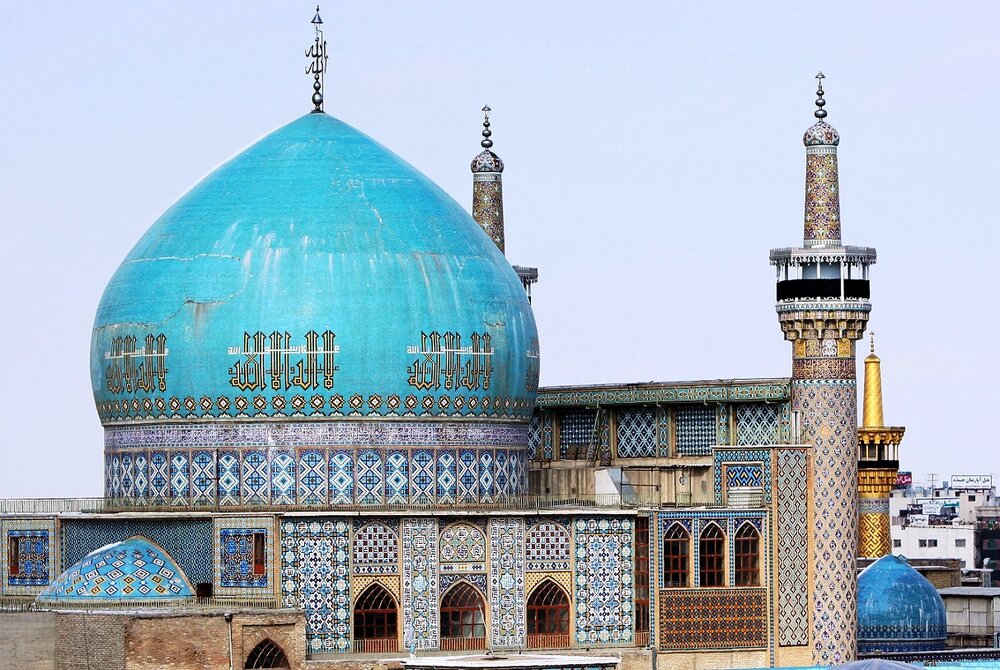Goharshad Mosque highly distinctive in terms of history, beauty, and architecture

TEHRAN - The great mosque of Goharshad is an astonishing Islamic structure due to its age, architectural characteristics, and rich tile decorations.
Since its construction in the early 15th century, it has served as a Friday Mosque for pilgrims to the shrine of Imam Reza (AS) in Mashhad.
Over the centuries, several new buildings have been added to the shrine complex, but the Timurid mosque remained one of the most dominant monuments and the only place for congregational prayer.
The construction started in 1418 by the order of Queen Goharshad, the wife of Shahrokh. The mosque took about 12 years to be completed under the supervision of capable Iranian architect Ghavameddin Shirazi by the use of the architectural and decorative manpower supplied from the Iranian cities of Shiraz and Isfahan.
Covering an area of about 10,000 square meters, the mosque consists of a large azure dome, two 40-meter minarets, four verandas, a courtyard with seven big bed-chambers, and a large altar made of a stony dado and mosaic faience shell.
Standing in the courtyard one can recognize the ensemble’s cheerful color and solidity among the tower-like minarets, merging with the outer corners of the portal screen spreading to the ground together with the high foundation revetment of marble.
The entire court facade is faced with enamel brick and mosaic faience of the finest quality.
The entire surface of the minarets, walls, and the surrounding colonnades are decorated with fine mosaic and glazed tiles produced in a variety of colors including ultramarine, turquoise, white, clear green, yellow, light yellow, and ebony.
The lucid and vigorous patterns are artfully adapted to their decorative role, whether for eye panels, or dome ornament meant to be effective at a thousand feet.
This is accomplished by the energy of the faience floral patterns and brick geometrical schemes; by the emphatic rhythm of the arcades, open galleries, and deep recesses.
On the margins of the main veranda’s entrance, there is an old inscription carved by the famed Iranian calligrapher Baysunqur Mirza. This comprehensive deed of endowment suggests that the mosque was built when Shahrokh, the Timurid king, was on the throne.
The northern veranda of the Goharshad Mosque or Dar al-Siyadeh, which has the shallowest veranda measuring 18x12 meters, was constructed concerning the inscription on the portal in 1087 lunar hejira during the time of Suleiman Shah of Safavid Dynasty.
The eastern veranda measuring 7x1 meters and the western one measuring 1x3 have rich tile work decorations. The mosque has a broad courtyard measuring 56x51 square meters which have been restricted by verandas and colonnades.
The mosaic faience of the courtyard is covered by dark stone and the rest of the surface is decorated with tiles of flora, artistic and arabesque designs.
The main dome of the building constitutes two dissociated onion-like layers with a short shaft and a hatchway diameter of 15 meters, a circumference of 63, and a thickness of 5.2 meters. The convex part of the dome’s shell is decorated with an inscription in the Kufic script.
Moreover, the mosque has a public library holding a large number of books. There is also a museum that represents various handicrafts including a collection of carpets and gold-woven works donated to the holy shrine of Imam Reza. Most of the gold-woven works date back to the 11th and 12th centuries. Among precious artifacts of this museum are the handwriting inscriptions by Ali Reza Abbasi, the renowned Safavid calligrapher, and painter.
The Goharshad Mosque was renovated several times when Shah Abbas, the powerful Safavid king, was on the throne. He contributed a lot to the restoration, construction, and reconstruction of various religious and historic sites in the country. However, time marches on and the mosque was relatively ruined by a devastating earthquake that happened in 1803.
It was time for Qajars to undertake required renovations in the early 19th century.
Another disaster that happened by the 1911 Russian bombings resulted in severe damage to the mosque’s double-layered dome.
Distinctive in its beauty and architecture, the Goharshad Mosque is still standing firm to host millions of pilgrims every year and maintain its position as one of the most magnificent mosques of Central Asia.
AFM
